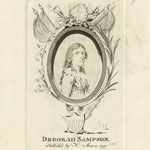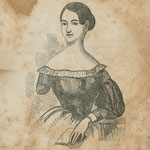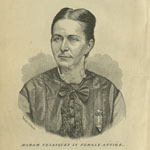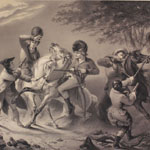 |
[George] Graham after [J. J.] Barralet. Deborah Sampson. Philadelphia: Published by H. Mann, 1797. Gift of John A. McAllister.
Sampson (1760-1827) served as a soldier for seventeen months during the American Revolution as “Robert Shurtliff.” This portrait is the frontispiece from her 1797 memoir, The Female Review, written in collaboration with Herman Mann. Through the memoir we learn that her height helped her succeed in the deception, “her stature is more than middle size; that is, five feet and seven inches.” (During this time the average woman’s height was five foot, while a man’s was five foot, four inches.) The book turned her into a celebrity and sent her on a lecture tour from 1802 to 1803. She even won her quest for veteran’s benefits in 1805. |
 |
Sophia Johnson. The Friendless Orphan: An Affecting Narrative of the Trials and Afflictions of Sophia Johnson, the Early Victim of a Cruel Step-Mother. Whose Afflictions and Singular Adventures Probably Exceed Those of Any Other American Female Living. Pittsburgh: S. Johnson, 1842.
There are a number of accounts of women disguising themselves as men when traveling to safeguard against harassment. Sophia Johnson did just that when she fled her stepmother’s house in pursuit of her brother, who was a soldier. She found her brother outside Buffalo, and she convinced him she could perform the duties of a soldier and enlisted. Thrown into battle almost immediately, she witnessed “the killed and wounded lying on my right side and left. . . .” She did not escape injury in her second battle and suffered a bullet wound to her arm, which had to be amputated. Sophia returned to her hometown where she supported herself as a teacher. |
 |
Loreta Janeta Velazquez. The Woman in Battle: A Narrative of the Exploits, Adventures, and Travels of Madame Loreta Janeta Velazquez, Otherwise Known as Lieutenant Harry J. Buford, Confederate States Army. Hartford: T. Belknap, 1876.
Masquerading as “Lieutenant Harry J. Buford,” Velazquez offered the most detailed description of how she concealed her sex. “Braiding my hair very close, I put on a man’s wig, and a false mustache, and by tucking in my pantaloons in my boots . . . I managed to transform myself into a very presentable man. I was doing my best to walk with a masculine gait, and to behave as if I had been accustomed to wear pantaloons all my life.” Heavy padding was too uncomfortable to wear every day, so Loreta found a tailor to make fine wire net shields which gave her the shape of a man. Bands at the base of her undershirt made her pants come out to hide her feminine waist. |
 |
R.E.A., engraver. Madame Velasquez in Female Attire from The Woman in Battle: A Narrative of the Exploits, Adventures, and Travels of Madame Loreta Janeta Velazquez, Otherwise Known as Lieutenant Harry J. Buford, Confederate States Army. Hartford: T. Belknap, 1876. [Facsimile]. |
 |
Claude Régnier after sketches by Felix Octavius Carr Darley. Elizabeth Grace and Rachel Martin. Tinted lithograph. New York: Goupil & Co., 1853. Gift of David Doret.
This dramatic print depicts sisters-in-law Grace and Rachel Martin disguised in their husbands’ clothing successfully intercepting at gunpoint a dispatch intended for British troops near their South Carolina home. The two women then brought the stolen information to the American forces. When the intercepted British troops later sought refuge in the Martin homestead, the women’s mother-in-law Elizabeth Martin successfully diverted the soldiers’ attention away from Grace and Rachel. Author Elizabeth Ellett related the exploits of the three women in the first volume of Women of the American Revolution (New York, 1848). |